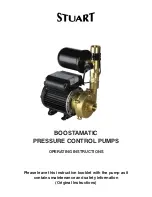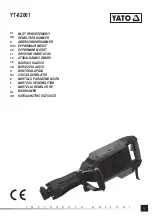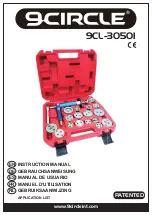
Good motor performance depends on proper
voltage. Extension cords that are too long and/
or too small in wire gauge reduce the voltage
to the motor under load. Use extension cords
no smaller than indicated below.
2.
Check the Parallel Alignment
*
The Conveyor Cart (4) should travel parallel to
the plane of the Blade (Q).
*
Place a Square rule against the backstop of the
Cart (4), lightly in contact with the Blade (Q). The
blade surface should be parallel to the square;
i.e., no gap between the blade and the square at
either the front or back edge of the blade. Next,
traverse the cart back and forth along the Rails.
The blade should remain parallel to the square,
staying slightly in contact with it throughout its
full travel. It should not move away from the
Blade nor should the Blade push the the Square
away. If the either happens, the Blade (Q) will
not cut straight and the Parallel Alignment must
be performed.
The motor is equipped with a manual overload protection
reset button. If the motors overheats, the red reset button
will “pop out” to open the motor circuit; stopping the motor
and water pump. If this occurs , the motor ON/OFF switch
must be set to OFF. After the motor cools, push in the reset
button. When it stays in, the motor can be restarted.
MOTOR F.L. AMPS 50’ Cord 75’ Cord 100’ Cord
HP RPM 115V 230V 115V 230V 115V 230V 115V 230V
.
1-1/2 1725 14.6
#12
#10
#8
.
1-1/2 3450 17.2 8.6 #10 #14 #10 #14 #8
#14
6
MANUAL THERMAL OVERLOAD
7
RECOMMENDED EXTENSION
..
8
ALIGNMENT PROCEDURES
A Lockbar (G) is used to set the blade depth during cutting.
The lockbar has three (3) holes at the lower end for use
with 10”, 8” and 6” blades. Refer to chart in Figure 3.
These are used as depth-limiting settings that, if used with
the correct blade diameter, will protect the rolling cart from
being cut by the blade.
The tilesaw is shipped standard set-up for a 10” diameter
blade. To change the setting, locate the capscrew (AA)
used as the pivot, loosen and remove the Lock Nut. Set
the Lockbar (G) at the proper hole for blade size. Tighten
the 5/16” fasteners so that the Lockbar (G) is snug but free
to pivot. Check the setting by loosening the Knob (F) and
lowering the head fully down into the table slot. The blade
segment should be below the table surface, but not cutting
into the table. (See also Section 10, Plunge Cutting.)
Your tile saw is factory assembled and aligned prior
to shipment to ensure accurate cuts when your saw is
delivered. However, since
Husqvarna®
cannot control
rough handling during shipping, it is suggested that the
alignment be checked. If the saw is found in need of
adjustment, refer to the appropriate section(s) below.
There are two basic alignment checks for the tilesaw
and
any adjustments made must follow these procedures to
ensure that the unit functions freely.
Adjustment tools required: Carpenter’s Square, two (2)
7/16” wrenches, 1/2” wrench, 9/16” wrench and 5/32” hex
key.
1.
Check the Blade in Slot Alignment
*
The Blade (Q) should be centered in the middle
slot of Conveyor Cart (4).
*
Set-up your saw as described above and move
the Conveyor Cart (4) back and forth from the
front to the rear of the Pan (2). If the Blade (Q)
contacts either side of the slot, the Cutting Head
Location Adjustment must be performed.
Cutting Head Adjustment (See Figure 1)
*
The Cutting Head Assembly (3) is positioned
with the Set Collar (U) against the left side of the
Motor platform and the Head Position Limiter
(V) against the inside.
*
Loosen the Set Collar (5/32” hex key), the
Position Limiter (9/16” wrench) and the four
(4) fasteners (1/2” wrench) of the Bearing Cap
(D).
*
Move the Head Assembly (3) along the Pivot Bar
of the Frame (1) until the Blade (Q) is centered
in the center slot. Locate the Set Collar (U)
against the outside of the Motor platform again
and retighten the set screw. Locate the Head
Position Limiter (V) against the inside wall of
the Motor platform, adjust to limit the Cutting
Head movement (See
section 10
) and tighten
the 3/8”-16 Bolt.
*
Check that the Blade is now in the center of the
middle slot. Tighten the four (4) fasteners of the
5
ADJUSTABLE LOCKBAR WITH
DEPTH LINKING PROTECTION
FIGURE 3








































